
Gondwanatheria is an extinct group of mammaliaforms that lived in parts of Gondwana, including Madagascar, India, South America, Africa, and Antarctica during the Upper Cretaceous through the Paleogene. Until recently, they were known only from fragmentary remains. They are generally considered to be closely related to the multituberculates and likely the euharamiyidians, well known from the Northern Hemisphere, with which they form the clade Allotheria.
Ferugliotherium is a genus of fossil mammals in the family Ferugliotheriidae from the Campanian and/or Maastrichtian period of Argentina. It contains a single species, Ferugliotherium windhauseni, which was first described in 1986. Although originally interpreted on the basis of a single brachydont (low-crowned) molar as a member of Multituberculata, an extinct group of small, rodent-like mammals, it was recognized as related to the hypsodont (high-crowned) Sudamericidae following the discovery of additional material in the early 1990s. After a jaw of the sudamericid Sudamerica was described in 1999, these animals were no longer considered to be multituberculates and a few fossils that were previously considered to be Ferugliotherium were assigned to unspecified multituberculates instead. Since 2005, a relationship between gondwanatheres and multituberculates has again received support. A closely related animal, Trapalcotherium, was described in 2009 on the basis of a single tooth.
Lavanify is a mammalian genus from the late Cretaceous of Madagascar. The only species, L. miolaka, is known from two isolated teeth, one of which is damaged. The teeth were collected in 1995–1996 and described in 1997. The animal is classified as a member of Gondwanatheria, an enigmatic extinct group with unclear phylogenetic relationships, and within Gondwanatheria as a member of the family Sudamericidae. Lavanify is most closely related to the Indian Bharattherium; the South American Sudamerica and Gondwanatherium are more distantly related. Gondwanatheres probably ate hard plant material.
Ferugliotheriidae is one of three known families in the order Gondwanatheria, an enigmatic group of extinct mammals. Gondwanatheres have been classified as a group of uncertain affinities or as members of Multituberculata, a major extinct mammalian order. The best-known representative of Ferugliotheriidae is the genus Ferugliotherium from the Late Cretaceous epoch in Argentina. A second genus, Trapalcotherium, is known from a single tooth, a first lower molariform, from a different Late Cretaceous Argentinean locality. Another genus known from a single tooth, Argentodites, was first described as an unrelated multituberculate, but later identified as possibly related to Ferugliotherium. Finally, a single tooth from the Paleogene of Peru, LACM 149371, perhaps a last upper molariform, and a recent specimen from Mexico, may represent related animals.

Echinodon is a genus of heterodontosaurid dinosaur that lived during the earliest Cretaceous of southern England and possibly western France in the Berriasian epoch. The first specimens were jaw bones named Echinodon becklesii by Sir Richard Owen in 1861, and since their original description only additional teeth have been discovered. The specific name honours collector Samuel Beckles who discovered the material of Echinodon and many other taxa from across England, while the genus name translates as "prickly tooth" in reference to the dental anatomy of the taxon.

Doratodon is an extinct genus of Late Cretaceous crocodylomorph that may have been a member of the Sebecosuchia. Doratodon was a relatively small animal with ziphodont teeth, meaning the teeth had flattened sides and serrated edges. Two species of Doratodon are known to science: D. carcharidens from Austria and Hungary, the type species; and D. ibericus from Spain. Teeth similar to those of Doratodon are also known from Italy and Romania, though they cannot be confidently assigned to this genus.
UA 8699 is a fossil mammalian tooth from the Cretaceous of Madagascar. A broken lower molar about 3.5 mm (0.14 in) long, it is from the Maastrichtian of the Maevarano Formation in northwestern Madagascar. Details of its crown morphology indicate that it is a boreosphenidan, a member of the group that includes living marsupials and placental mammals. David W. Krause, who first described the tooth in 2001, interpreted it as a marsupial on the basis of five shared characters, but in 2003 Averianov and others noted that all those are shared by zhelestid placentals and favored a close relationship between UA 8699 and the Spanish zhelestid Lainodon. Krause used the tooth as evidence that marsupials were present on the southern continents (Gondwana) as early as the late Cretaceous and Averianov and colleagues proposed that the tooth represented another example of faunal exchange between Africa and Europe at the time.
Several mammals are known from the Mesozoic of Madagascar. The Bathonian Ambondro, known from a piece of jaw with three teeth, is the earliest known mammal with molars showing the modern, tribosphenic pattern that is characteristic of marsupial and placental mammals. Interpretations of its affinities have differed; one proposal places it in a group known as Australosphenida with other Mesozoic tribosphenic mammals from the southern continents (Gondwana) as well as the monotremes, while others favor closer affinities with northern (Laurasian) tribosphenic mammals or specifically with placentals. At least five species are known from the Maastrichtian, including a yet undescribed species known from a nearly complete skeleton that may represent a completely new group of mammals. The gondwanathere Lavanify, known from two teeth, is most closely related to other gondwanatheres found in India and Argentina. Two other teeth may represent another gondwanathere or a different kind of mammal. One molar fragment is one of the few known remains of a multituberculate mammal from Gondwana and another has been interpreted as either a marsupial or a placental.
Argentodites is a possible multituberculate mammal from the Cretaceous of Argentina. The single species, Argentodites coloniensis, is known from a single blade-like fourth lower premolar (p4) from the La Colonia Formation, which is mostly or entirely Maastrichtian in age. The p4 is 4.15 mm long and bears eight cusps on its upper margin and long associated ridges on both sides. The enamel consists of prisms that are completely or partly surrounded by a sheath and that are on average 6.57 μm apart. Zofia Kielan-Jaworowska, who described and named the fossil in 2007, regarded it as a multituberculate, perhaps a cimolodontan—and thus, a member of a mostly Laurasian (northern) group and an immigrant to Argentina from North America—on the basis of the shape of the tooth and features of its enamel. In 2009, however, two teams argued that Argentodites may in fact be close to or identical with Ferugliotherium, a member of the small Gondwanan (southern) group Gondwanatheria; although their relationships are disputed, gondwanatheres may themselves be multituberculates.
LACM 149371 is an enigmatic fossil mammalian tooth from the Paleogene of Peru. It is from the Santa Rosa fossil site, which is of uncertain age but possibly late Eocene or Oligocene. The tooth is poorly preserved and may have been degraded by acidic water or because it passed through a predator's digestive tract. Its largest dimension is 2.65 mm. It is triangular in shape and bears six cusps that surround the middle of the tooth, where there are three basins (fossae). Crests connects the cusps and separate the fossae. The microscopic structure of the enamel is poorly preserved.
Trapalcotherium is a fossil mammal from the Cretaceous of Argentina in the family Ferugliotheriidae. The single species, T. matuastensis, is known from one tooth, a first lower molar. It is from the Allen Formation, which is probably Maastrichtian in age, and was first described in 2009. The tooth bears two rows of cusps, one at the inner (lingual) side and the other at the outer (labial) side, which are connected by transverse ridges separated by deep valleys. This pattern is reminiscent of Ferugliotherium, a gondwanathere mammal from similarly aged deposits in Argentina, and Trapalcotherium is therefore recognized as a member of the same family Ferugliotheriidae. Ferugliotheriidae is one of two families of gondwanatheres, an enigmatic group without close relationships to any living mammals.

Teeth are common to most vertebrates, but mammalian teeth are distinctive in having a variety of shapes and functions. This feature first arose among early therapsids during the Permian, and has continued to the present day. All therapsid groups with the exception of the mammals are now extinct, but each of these groups possessed different tooth patterns, which aids with the classification of fossils.
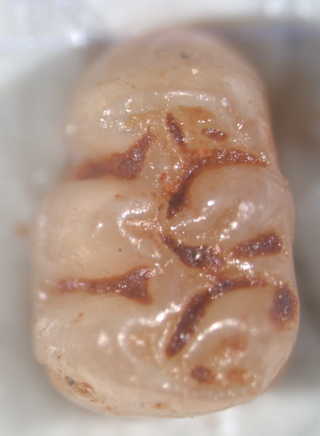
Agathaeromys is an extinct genus of oryzomyine rodents from the Pleistocene of Bonaire, Netherlands Antilles. Two species are known, which differ in size and some details of tooth morphology. The larger A. donovani, the type species, is known from hundreds of teeth that are probably 900,000 to 540,000 years old, found in four localities. A. praeuniversitatis, the smaller species, is known from 35 teeth found in a single fossil site, which is probably 540,000 to 230,000 years old.
Bharattherium is a mammal that lived in India during the Maastrichtian and possibly the Paleocene. The genus has a single species, Bharattherium bonapartei. It is part of the gondwanathere family Sudamericidae, which is also found in Madagascar and South America during the latest Cretaceous. The first fossil of Bharattherium was discovered in 1989 and published in 1997, but the animal was not named until 2007, when two teams independently named the animal Bharattherium bonapartei and Dakshina jederi. The latter name is now a synonym. Bharattherium is known from a total of eight isolated fossil teeth, including one incisor and seven molariforms.
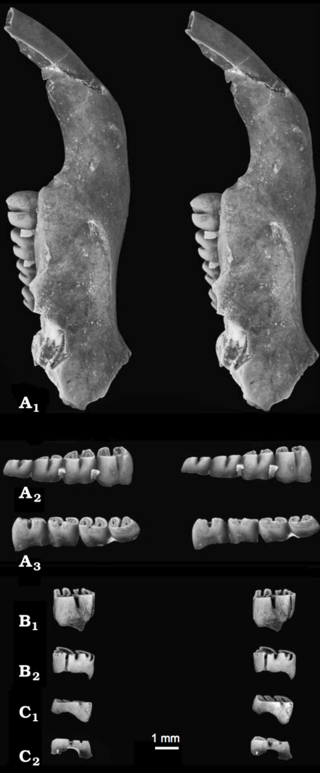
Apeomyoides savagei is a fossil rodent from the Miocene of the United States, the only species in the genus Apeomyoides. It is known from fragmentary jaws and isolated teeth from a site in the early Barstovian, around 15–16 million years ago, of Nevada. Together with other species from scattered localities in the United States, Japan, and Europe, Apeomyoides is classified in the subfamily Apeomyinae of the extinct rodent family Eomyidae. Apeomyines are a rare but widespread group that may have been adapted to a relatively dry habitat.
Patagonia is an extinct genus of non-placental mammal from the Miocene of Argentina. Traditionally considered a metatherian incertae sedis, one analysis suggested it to be a gondwanathere. However, this has been rejected by other authors.
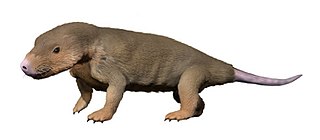
Abdalodon is an extinct genus of late Permian cynodonts, known by its only species A. diastematicus.Abdalodon together with the genus Charassognathus, form the clade Charassognathidae. This clade represents the earliest known cynodonts, and is the first known radiation of Permian cynodonts.

Gordodon is an extinct genus of non-mammalian synapsid that lived during the Early Permian of what is now Otero County, New Mexico. It was a member of the herbivorous sail-backed family Edaphosauridae and contains only a single species, the type species G. kraineri. Gordodon is unusual among early synapsids for its teeth, which were arranged similarly to those of modern mammals and unlike the simple, uniform lizard-like teeth of other early herbivorous synapsids. Gordodon had large incisor-like teeth at the front, followed by a prominent gap between them and a short row of peg-like teeth at the back. Gordodon was also relatively long-necked for an early synapsid, with elongated and gracile vertebrae in its neck and back. Like other edaphosaurids, Gordodon had a tall sail on its back made from the bony neural spines of its vertebrae. The spines also had bony knobs on them, a common trait of edaphosaurids, but the knobs of Gordodon are also unique for being more slender, thorn-like and randomly arranged along the spines. It is estimated to have been rather small at 1 m in length excluding the tail and 34 kg (75 lb) in weight.
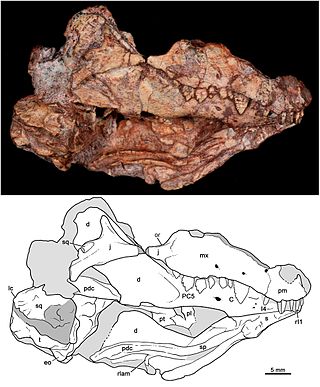
Bonacynodon is an extinct genus of cynodonts that lived in what is now southern Brazil during the Triassic period. The genus is monotypic, containing only the type species Bonacynodon schultzi. B. schultzi is known from two specimens, consisting of two partial skulls and some badly preserved parts of the postcranium. Both specimens were recovered from the Pinheiros-Chiniquá Sequence, part of the Santa Maria Supersequence of the Paraná Basin. This sequence preserves a faunal association known as the Dinodontosaurus Assemblage Zone, which contains numerous other species of cynodonts, dicynodonts and reptiles. Bonacynodon was a small, likely insectivorous cynodont, whose length has been estimated at around 30 centimetres (12 in). It can be distinguished from other cynodonts by its large, serrated (saw-like) canine teeth. Together with the genus Probainognathus of Argentina, it made up the family Probainognathidae, one of the earliest-diverging lineages of the clade Probainognathia. It was a fairly close relative of mammals, the only group of cynodonts alive today.
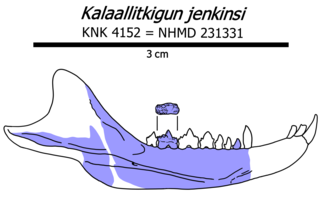
Kalaallitkigun is an extinct genus of haramiyidan mammaliaforms from the Late Triassic of Greenland. It contains a single species, Kalaallitkigun jenkinsi, which was described in 2020 from a partial dentary found in the Fleming Fjord Formation. More specifically, it was found in the mid-late Norian Carlsberg Fjord beds of the Ørsted Dal Member. It is the oldest of several mammaliaform species discovered in the Late Triassic sediments of Greenland. It is also the oldest mammaliaform with double-rooted teeth, and its pattern of tooth cusps help to clarify the evolution of haramiyidan teeth relative to their morganucodont-like ancestors.













